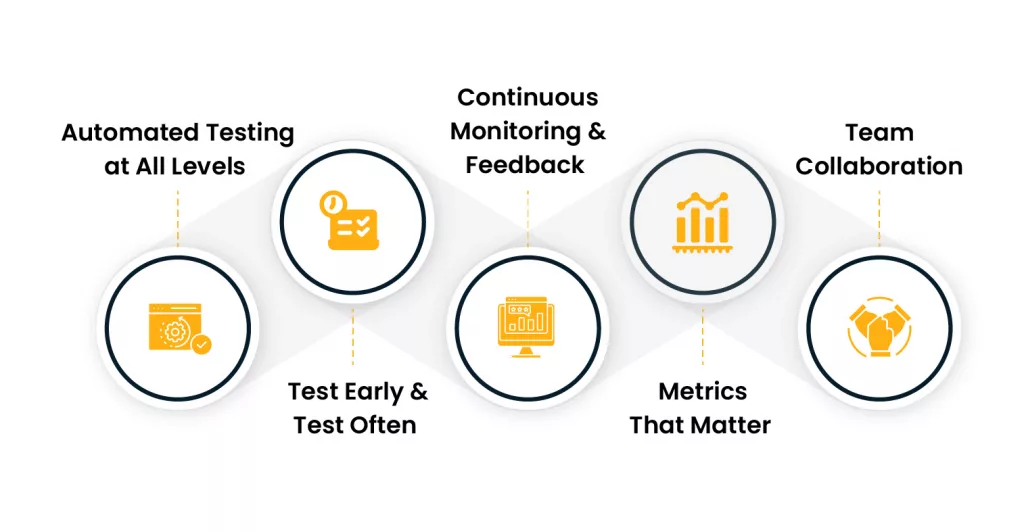If your team is still catching bugs late in the software development cycle—or worse, hearing about them from customers first—it’s a sign your process needs attention. Adding more testers won’t fix the root problem.
The real solution is to change how quality is approached across the lifecycle. Instead of checking for problems at the end, leading teams are building quality into the product from the ground up. That shift is known as quality engineering.
So, what is quality engineering, and why are so many businesses prioritizing it today?
We will explain everything: what it is, how it helps teams deliver faster with fewer issues, and more.
What Is Quality Engineering?
Quality engineering is the discipline of embedding quality checks and measures throughout the entire development cycle. It doesn’t wait until the end to test. On the contrary, it actively prevents problems by introducing the following things from the beginning:
- Testing
- Automation
- Monitoring
- Continuous feedback
The first mention of “testing early” usually points to shift-left testing, a key component of modern quality engineering. But it’s more than just early testing. It’s about smart processes, automation, fast feedback loops, and data-backed decisions—all working together to ensure reliability and performance.
What it involves:
- Planning test strategies alongside developers and business teams
- Using automation to minimize human error and speed up releases
- Monitoring systems before and after they go live
- Analyzing data to improve software quality over time
You can think of it this way: Quality engineering is what helps a product work the way your customers expect every time.
Quality Engineering vs. Quality Assurance Engineering
Let’s clear up another common question—what is quality assurance engineering, and how is it different?
While quality assurance focuses on verifying that the final product meets certain standards or requirements, quality engineering focuses on building quality into every stage of the lifecycle.
A simple breakdown:
| Category | Quality Engineering | Quality Assurance Engineering |
| When it starts | From the beginning of development | Near the end, usually during testing |
| Main goal | Prevent defects | Detect and fix defects |
| Approach | Continuous testing and monitoring | Final validation and manual checks |
| Tools used | Automation tools, real-time monitoring | Test cases, bug tracking tools |
| Team collaboration | Cross-functional with dev, ops, product | QA and testing teams |
Both roles are important, but without quality engineering, you’re left cleaning up issues that could’ve been avoided in the first place.
Why Businesses Are Prioritizing Quality Engineering
Poor quality costs real money. And here’s the proof: According to a 2023 report by CISQ, software failures cost US businesses over $2.4 trillion in 2022 across operational failures, customer support, and lost revenue.
That’s why many businesses are changing their strategy. Instead of adding more testers, they’re focusing on smart engineering processes that reduce issues in the first place.
Benefits of having quality engineering in place:
- You catch bugs early, when they’re cheaper to fix
- Releases happen faster with fewer rollbacks
- Customer complaints drop
- Systems run smoother with less downtime
- You reduce dependency on reactive firefighting
These aren’t small wins—they’re critical for any business relying on digital products or services.
Building a Quality Engineering Strategy That Works

Now that you know what is quality engineering, it’s extremely crucial to know how to apply it to your company. For that, you need a well-thought-out quality engineering strategy. It will help align your team, tools, and process toward a shared goal: reliable, maintainable, and efficient software.
Here’s what a strong strategy should include:
1. Automated Testing at All Levels
Automation should cover the following things:
- Unit
- Integration
- UI
- Performance testing
That doesn’t mean doing away with manual testers—it means giving them time to focus on edge cases, exploratory testing, and real user scenarios.
2. Test Early and Test Often
This is the heart of shift-left testing. If your team waits until a release is close, it’s too late. Start testing requirements and logic from the first planning session.
3. Continuous Monitoring and Feedback
Use logs, alerts, dashboards, and metrics to constantly measure product health. Real-time feedback helps engineers fix problems before customers even notice.
4. Metrics That Matter
Your team should know:
- Test pass/fail rates
- Code coverage
- Defect trends over time
- Time to detect and time to fix
These numbers help you make informed decisions instead of relying on assumptions.
5. Team Collaboration
Developers, product owners, operations, and testers should all take part in quality. It’s not just QA’s job anymore. Quality engineering promotes a culture of shared responsibility.
When done right, your quality engineering strategy becomes a competitive advantage—not just a process.
What to Expect from Quality Engineering and Assurance Services
If you’re working with a vendor or consultant offering quality engineering services, here’s what you should expect:
Broad Technical Coverage
Services should include everything from test automation frameworks to performance monitoring, security testing, and CI/CD pipeline integration.
Custom Implementation Plans
A good service partner will tailor their approach based on your team size, release cycles, infrastructure, and business priorities.
Ongoing Support and Skill Development
It’s not just about tools—it’s also about helping your in-house teams build the right habits and technical skills.
Measurable Results
Look for services that provide dashboards, reports, and analytics that track value over time.
Flexibility and Integration
Your vendor should integrate seamlessly with your systems and teams, not just drop in a framework and leave.
The best quality engineering and assurance services don’t just plug a gap—they become an active part of your development culture.
Common Challenges (And How to Handle Them)
Like any shift in process, quality engineering comes with challenges. Here’s how to deal with a few of them:
1. Resistance from Development Teams
Some developers feel that quality is QA’s job. But the truth is, when developers write tests, bugs go down, and they save time in the long run. Solve this with education and small wins.
2. Choosing the Right Tools
There’s no single tool that fits all. Select tools based on:
- Your programming language
- Existing infrastructure
- Team skill level
- Budget and license limits
Don’t chase hype. Focus on practical needs.
3. Lack of Clear Goals
It’s easy to automate everything without knowing why. Set clear outcomes like “Reduce post-release defects by 40% in 6 months” or “Achieve 90% test automation coverage.”
4. Skill Gaps
If your in-house team lacks automation skills or testing knowledge, consider short-term training or partnering with experts through quality engineering and assurance services.
What You Prevent Matters More Than You Fix!
Many businesses treat quality as a final step. But the real differentiators in today’s market are those that see it as a continuous, strategic function.
Quality engineering isn’t just about fewer bugs—it’s about building better systems, faster feedback loops, and fewer missed opportunities. As your software becomes more central to your operations, the cost of avoidable errors only grows. A solid quality approach is no longer optional. It’s what keeps teams aligned, products stable, and customers loyal.
Businesses that invest in proactive quality today won’t just fix fewer problems—they’ll ship smarter, scale better, and stay ahead. The question isn’t “Should we start?” It’s “How much are we losing by waiting?”











